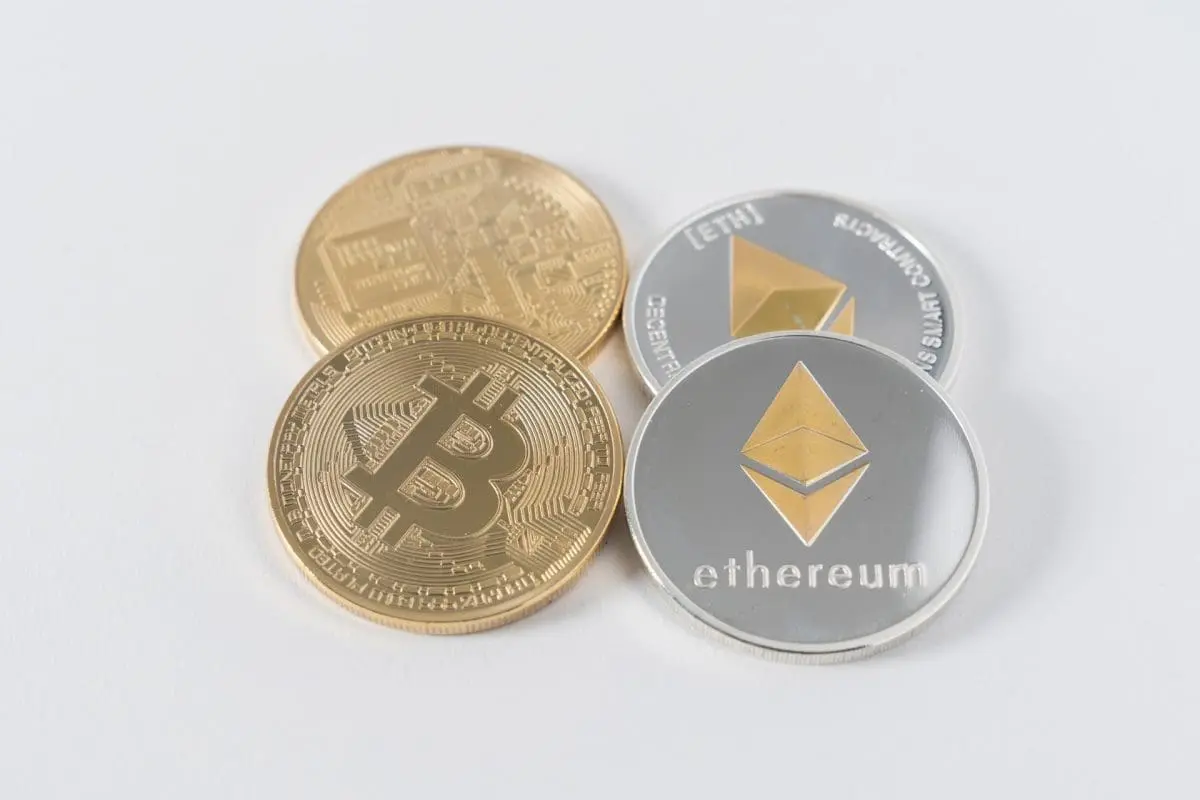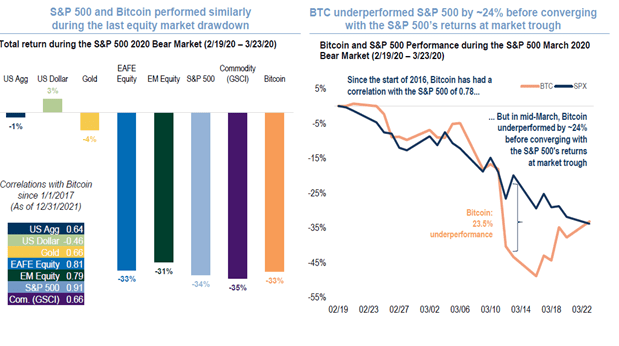
Insights
February 23, 2022
Cryptocurrency Overview
In Investments

Key Points
- Cryptocurrencies are created using a distributed peer-to-peer verified ledger known as blockchain.
- Cryptocurrencies are decentralized, which means they are not regulated, issued, or backed by a central governmental authority or a financial institution.
- Cryptocurrencies are still in their infancy and display extreme volatility. Additionally, they are speculative since they cannot be objectively valued as they are not backed by cash flows or assets and rely solely on sentiment. For these reasons, Coldstream does not recommend investing in cryptocurrencies; however, we are providing this informational piece to let our clients know the various options in investing in cryptocurrencies if they would like to do so on their own.
- Cryptocurrencies are generally stored in digital wallets provided by an exchange. This allows users to manage and trade their currencies.
- The IRS views cryptocurrency as property, and all dispositions must be accounted for via capital gains and losses.
Introduction
As of December 2021, the total market capitalization of cryptocurrency was almost $2.3 trillion. Bitcoin, the world’s largest cryptocurrency, began 2021 with a 70% market share. However, this number has fallen to around 40% as other currencies’ popularity increased, such as Ethereum, which now has the second-largest market share. There are over 8,000 cryptocurrencies, each designed to provide a new feature or function. This article will explore blockchain, cryptocurrency, cryptocurrency allocation and risk, accessibility, and tax implications.
What is Blockchain?
Blockchain technology has a variety of applications. However, this article focuses on its utilization in digital currencies. A blockchain is a permanent, indestructible ledger recording economic transactions. The blockchain ledger is stored on many independent “node” computers. Every transaction on the chain is broadcast to every node, and nodes constantly compare and verify their copies of the ledger to prevent accidental or deliberate errors. Most cryptocurrencies “pay” nodes for this work by periodically awarding small quantities of new currency to a random node. The blockchain is thus decentralized, which means that no single party like a government, financial institution, or individual controls it. Each cryptocurrency has its own unique blockchain.
What is Cryptocurrency?
Cryptocurrency is digital money designed to be utilized over the internet. These currencies can be exchanged for goods and services, though they are more often used as investment vehicles. Cryptocurrencies aren’t like fiat currencies, such as the dollar, euro, or yen. Fiat currencies are issued and regulated by nations or groups of nations, and major global currencies operate as stores of value and media of exchange. Meaning: fiat currencies can be used to hold wealth and transact for goods and services. Cryptocurrencies are decentralized, which means no central authority regulates or supports them. As discussed above, cryptocurrencies utilize blockchain technology to record transactions and issue new units. Although the number is growing, very few parties currently accept cryptocurrencies as payment, limiting their use as a media of exchange, and cryptocurrencies’ extreme volatility means they are not stable stores of value.
Cryptocurrency Allocation: Client Portfolio

Source: Goldman Sachs
When constructing client portfolios, Coldstream utilizes investments with one or more of the following characteristics: has an intrinsic value, generates steady cash flows, produces earnings, or provides a diversification benefit. Bitcoin and other cryptocurrencies display none of these characteristics. Without indicators of intrinsic value, buying or selling a cryptocurrency is a purely speculative, momentum-based decision. Currently, cryptocurrencies do not offer a diversification benefit either, as their values have been correlated with equity indices, particularly on the downside.
Bitcoin & S&P 500 Recovery (12/31/19 – 12/31/21)

Source: Bloomberg
The S&P 500 recovered quickly with little volatility after reaching its trough in March of 2020 with the help of significant fiscal and monetary stimulus. Bitcoin followed suit with a correction in March. In the years following the correction, bitcoin had solid returns. This was seen in 2020, where bitcoin returned 302.8% and 57.6% in 2021. Bitcoin offers the attraction of enormous profits; however, this is accompanied by substantially higher risk. For example, since bitcoin’s inception in 2009, it has had a 72% probability of a 60%+ drawdown per year.
Bitcoin Correlation With “Meme Stocks” (03/02/21 – 02/19/22)

Source: Bloomberg
Bitcoin has been even more highly correlated with baskets of “meme stocks” like GameStop and AMC. There is no fundamental reason why the value of a cryptocurrency should move in tandem with these specific stocks, as sentiment and momentum, particularly among retail investors, tend to drive both.
Along with the volatility of cryptocurrencies, there are several significant risks, including:
- Fraud or theft: While the blockchain itself is designed to be resistant to these risks, cryptocurrency exchanges and “digital wallets” can be hacked, scammed, or fraudulent themselves. The failure of the Mt. Gox Bitcoin exchange in 2014 resulted in hundreds of millions of dollars of losses.
- Regulatory/legal risks: Regulations are still in the development process, and there are no legal precedents related to the new features of blockchain technology.
- ESG risks: Cryptocurrency mining involves specialized computers validating blockchain transactions for a specific cryptocurrency. Miners receive a reward for their computational effort. Unfortunately, this process is energy-intensive, and according to the Digiconomist Bitcoin Energy Index, bitcoin’s energy consumption would put it among the top 30 countries in the world. Additionally, cryptocurrencies are used as a payment method for ransomware attacks.
- Technological disruption: Blockchain technology is evolving rapidly, and new currencies are constantly being launched, which could potentially make today’s cryptocurrencies obsolete or reduce their value.
- Destruction of confidence in the ecosystem: Major cyberattacks, or computer programming errors may erode belief in blockchain technology and cryptocurrencies.
- Potential credit crisis: Some exchanges allow significant leverage, and as this behavior becomes more prevalent, the cryptocurrency market, just like any traditional financial system, could face a credit crisis.
Purchasing Cryptocurrencies
Despite these risks, if you would like to invest in cryptocurrency on your own, below are some options.
Direct Exposure
Purchasing cryptocurrency is the most direct way to gain exposure. The first step to owning cryptocurrency is to open an account with a cryptocurrency exchange. Coinbase is user-friendly and one of the most popular exchanges.
Pros of Coinbase:
- Intuitive, user-friendly interface and easy purchase process.
- A broad assortment of educational material.
- Wide selection of cryptocurrencies.
Cons of Coinbase:
- High fees.
Coinbase does provide services for its fees. Some include two-factor authentication on all versions of its platform, storage of 98% of customers’ crypto offline, and protection of cryptocurrency holdings through an insurance policy of up to $250,000 per FDIC coverage limits. Such robust measures provide protections that other cryptocurrency account providers do not. Once an account is funded with fiat currency, investors can issue an order to buy the cryptocurrency of their choice. Trades are made through an exchange, which matches buy orders with sell orders at the same price, executes the trade, and holds the cryptocurrency in a custodial wallet.
Bitcoin Futures ETFs
Bitcoin futures ETFs allow investors to gain exposure to bitcoin without using a digital currency exchange like Coinbase. Instead, the futures are purchased through traditional exchanges and markets.
These ETFs do not directly own bitcoin. Instead, they buy futures contracts which are agreements to buy or sell the asset later for an agreed-upon price. Such funds will generally track bitcoin prices but not always. This is because the market price of bitcoin and bitcoin futures tends to diverge based on the sentiment of futures traders. For example, if more futures traders think the price of bitcoin will rise, this will cause the value of contracts to be naturally higher than the market price of bitcoin. Consequently, these ETFs may occasionally diverge from Bitcoin’s market price.
BITO- Debuted on October 19th, 2021, making it the first U.S bitcoin-linked ETF. The ETF was designed to allow investors a convenient, liquid, and transparent way to gain exposure to bitcoin. This fund is primarily focused on capital appreciation through the use of bitcoin futures contracts. Currently, this is the largest bitcoin futures-linked ETF with 1.1B assets under management as of 02/16/2022. The management fee is 0.95%, which is relatively high when compared to traditional ETFs.
Thematic ETFs
Currently, there are several individual public companies involved in the cryptocurrency ecosystem. However, most are small and illiquid and have shown high volatility.
Thematic ETFs seek to provide broader exposure and reduce volatility through diversification. These ETFs own a basket of companies involved in the cryptocurrency ecosystem, such as cryptocurrency miners, semiconductor manufacturers who produce chips for miners, cryptocurrency exchanges, and companies providing financial services specific to cryptocurrency. Included below are some of the more prominent thematic ETFs in the space.
| Name | Ticker | Expense Ratio | # of Holdings |
|---|---|---|---|
| Amplify Transformational Data Sharing ETF | BLOK | 0.71 | 53 |
| Siren Nasdaq NexGen Economy ETF | BLCN | 0.68 | 65 |
| First Trust Indxx Innovation Transactn & Proc ETF | LEGR | 0.65 | 106 |
| Bitwise Crypto Industry Innovators ETF | BITQ | 0.85 | 34 |
| Global X Blockchain ETF | BKCH | 0.5 | 26 |
BLOK: An actively managed ETF that invests in the equity securities of companies actively involved in developing and utilizing blockchain technologies.
BLCN: Focuses on companies committed to developing, researching, or utilizing blockchain technologies.
LEGR: Tracks the Indxx Blockchain Index of exchange-listed companies across the globe that are either actively using, investing in, developing, or have products poised to benefit from blockchain technology.
BITQ: Tracks the Bitwise Crypto Innovators 30 Index that measures the performance of companies leading the rapidly emerging crypto economy. The index is primarily focused on pure-play crypto companies, including bitcoin- and crypto-trading venues, crypto mining and mining equipment firms, and service providers.
BKCH: Invests in companies poised to benefit from the increased adoption of blockchain technology, including companies in digital asset mining, digital asset transactions, blockchain applications, blockchain & digital asset hardware, and blockchain & digital asset integration.
Tax Implications
The IRS views cryptocurrency as investment property, and all dispositions must be accounted for via capital gains and losses. This means when bitcoin is sold to buy another cryptocurrency or a good/service, the gain or loss on the sale will have to be reported to the IRS with the cost and disposition prices.
Disclaimer: This material is not an offer or solicitation with respect to the purchase or sale of any security, nor does it constitute investment advice or tax advice, and is not intended as an endorsement of any specific investment or investment strategy. The particular investments and strategies displayed may not be appropriate for your specific situation, risk tolerance and financial goals.
Insights Tags
Related Articles

May 12, 2025
Why people make irrational financial decisions



April 14, 2025
Watch Coldstream’s MarketCast for Second Quarter 2025




April 4, 2025
Navigating Trump’s Tariff Bombshell: Trade War or Negotiating Tactic
